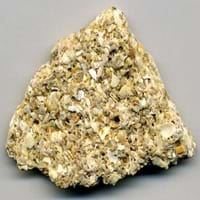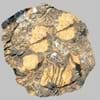Definition
Coquina is a sedimentary rock that is composed either wholly or almost entirely of the transported, abraded, and mechanically-sorted fragments of the shells of molluscs, trilobites, brachiopods, or other invertebrates
Basanite is a black basaltic rock which mainly contains plagioclase, augite, olivine and nepheline and is formerly used as a touchstone
Origin
European Foreland Basins
Unknown
Discoverer
Unknown
Unknown
Etymology
From Concha (Latin)+ Coquina(Spanish) +conch(English)= Couquina (mid 19th century)
From Latin basanites + -ite
Class
Sedimentary Rocks
Igneous Rocks
Sub-Class
Durable Rock, Soft Rock
Durable Rock, Hard Rock
Group
Not Applicable
Not Applicable
Other Categories
Coarse Grained Rock, Opaque Rock
Fine Grained Rock, Opaque Rock
Texture
Clastic
Aphanitic to Porphyritic
Color
Beige, Buff, Orange
Black, Brown, Green, Grey, Red, White
Durability
Non-Durable
Durable
Appearance
Layered, Banded, Veined and Shiny
Glassy or Pearly
Interior Uses
Decorative Aggregates, Homes, Hotels, Interior Decoration
Decorative Aggregates, Homes
Exterior Uses
Garden Decoration, Office Buildings
As Building Stone, Garden Decoration, Office Buildings
Other Architectural Uses
Curbing
Whetstones
Construction Industry
Building houses or walls, Construction Aggregate
Arrowheads, Construction Aggregate, Cutting Tool, Spear Points
Medical Industry
Not Yet Used
Not Yet Used
Antiquity Uses
Artifacts, Monuments, Sculpture, Small Figurines
Artifacts, Monuments
Commercial Uses
Creating Artwork
As a touchstone, Creating Artwork, Gemstone, In fire-starting tools, Manufacture of tools, Metallurgical Flux, Jewelry, To ignite fire, Used in flintlock firearms
Types
Not Available
Nepheline-Basanite, Analcite-Basanite and Leucite-Basanite
Features
Available in Lots of Colors and Patterns, Is one of the oldest rock
Clasts are smooth to touch, Easily splits into thin plates, Has High structural resistance against erosion and climate, Used as a touchstone
Archaeological Significance
Famous Monuments
Data Not Available
Data Not Available
Sculpture
Used
Not Yet Used
Famous Sculptures
Data Not Available
Not Applicable
Pictographs
Used
Not Used
Petroglyphs
Used
Not Used
Figurines
Used
Not Yet Used
Formation
Coquina is a sedimentary rock which is formed when billions of small clam-like seashell, called Coquina, or cockleshell are die and hence are deposited, buried and turns into a rock when pressure is applied.
Basanite is a fine-grained, hard rock that forms when bits of lava shoot out of volcanoes.
Mineral Content
Apatite, Augite, Bronzite, Calcite, Chert, Chlorite, Clay Minerals, Epidote, Feldspar, Garnet, Micas, Muscovite or Illite
Augite, Feldspar, Ilmenite, Olivine, Plagioclase
Compound Content
CaO, Carbon Dioxide, Iron(III) Oxide, MgO
Potassium Oxide, Sodium Oxide, Silicon Dioxide
Types of Metamorphism
Not Applicable
Burial Metamorphism, Cataclastic Metamorphism, Contact Metamorphism, Regional Metamorphism
Types of Weathering
Biological Weathering, Chemical Weathering, Mechanical Weathering
Chemical Weathering, Mechanical Weathering
Types of Erosion
Coastal Erosion, Sea Erosion, Water Erosion, Wind Erosion
Chemical Erosion, Coastal Erosion, Glacier Erosion, Sea Erosion, Water Erosion, Wind Erosion
Grain Size
Coarse Grained
Fine Grained
Fracture
Irregular
Uneven, Splintery or Conchoidal
Porosity
Highly Porous
Highly Porous
Luster
Dull to Vitreous to Submetallic
Waxy and Dull
Cleavage
Not Available
Non-Existent
Toughness
Not Available
1.5
Specific Gravity
1.10-2.24
2.5-2.8
Transparency
Opaque
Translucent to Opaque
Density
2.8-2.9 g/cm3
2.7 g/cm3
Specific Heat Capacity
Not Available
Resistance
Heat Resistant, Impact Resistant, Pressure Resistant, Wear Resistant
Heat Resistant, Impact Resistant, Pressure Resistant, Wear Resistant
Deposits in Eastern Continents
Asia
Not Yet Found
Not Yet Found
Africa
Not Yet Found
Uganda
Europe
United Kingdom
Germany, Hungary, Italy, Spain
Others
Not Yet Found
Greenland, Mid-Atlantic Ridge
Deposits in Western Continents
South America
Not Yet Found
Bolivia, Brazil
Deposits in Oceania Continent
Australia
Not Yet Found
New South Wales, New Zealand, Queensland, South Australia, Western Australia
All about Coquina and Basanite Properties
Know all about Coquina and Basanite properties here. All properties of rocks are important as they define the type of rock and its application. Coquina belongs to Sedimentary Rocks while Basanite belongs to Igneous Rocks.Texture of Coquina is Clastic whereas that of Basanite is Aphanitic to Porphyritic. Coquina appears Layered, Banded, Veined and Shiny and Basanite appears Glassy or Pearly. The luster of Coquina is dull to vitreous to submetallic while that of Basanite is waxy and dull. Coquina is available in beige, buff, orange colors whereas Basanite is available in black, brown, green, grey, red, white colors. The commercial uses of Coquina are creating artwork and that of Basanite are as a touchstone, creating artwork, gemstone, in fire-starting tools, manufacture of tools, metallurgical flux, jewelry, to ignite fire, used in flintlock firearms.










